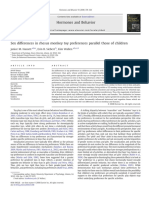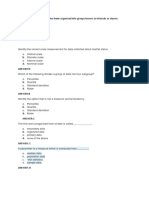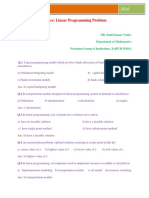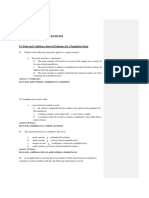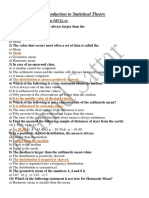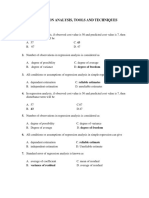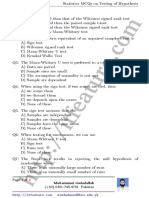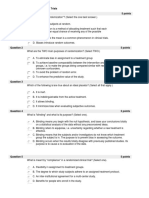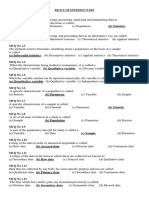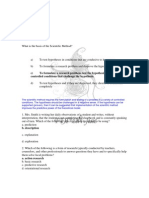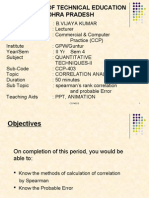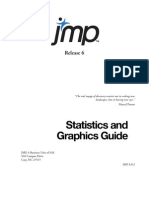100%(1)100% found this document useful (1 vote)
113 viewsMCs in Quizzes - SMA
MCs in Quizzes - SMA
Uploaded by
Many_Maryy221. Frequency distribution can be used to answer question A about the percentage of different user types of a brand.
2. Cross-tabulation describes the joint distribution of two or more categorical variables simultaneously through tables.
3. Cluster analysis is used in marketing to segment markets based on benefits sought but not to determine how advertising affects sales.
Copyright:
© All Rights Reserved
Available Formats
Download as PDF, TXT or read online from Scribd
MCs in Quizzes - SMA
MCs in Quizzes - SMA
Uploaded by
Many_Maryy22100%(1)100% found this document useful (1 vote)
113 views9 pages1. Frequency distribution can be used to answer question A about the percentage of different user types of a brand.
2. Cross-tabulation describes the joint distribution of two or more categorical variables simultaneously through tables.
3. Cluster analysis is used in marketing to segment markets based on benefits sought but not to determine how advertising affects sales.
Original Title
MCs in Quizzes- SMA
Copyright
© © All Rights Reserved
Available Formats
PDF, TXT or read online from Scribd
Share this document
Did you find this document useful?
Is this content inappropriate?
1. Frequency distribution can be used to answer question A about the percentage of different user types of a brand.
2. Cross-tabulation describes the joint distribution of two or more categorical variables simultaneously through tables.
3. Cluster analysis is used in marketing to segment markets based on benefits sought but not to determine how advertising affects sales.
Copyright:
© All Rights Reserved
Available Formats
Download as PDF, TXT or read online from Scribd
Download as pdf or txt
100%(1)100% found this document useful (1 vote)
113 views9 pagesMCs in Quizzes - SMA
MCs in Quizzes - SMA
Uploaded by
Many_Maryy221. Frequency distribution can be used to answer question A about the percentage of different user types of a brand.
2. Cross-tabulation describes the joint distribution of two or more categorical variables simultaneously through tables.
3. Cluster analysis is used in marketing to segment markets based on benefits sought but not to determine how advertising affects sales.
Copyright:
© All Rights Reserved
Available Formats
Download as PDF, TXT or read online from Scribd
Download as pdf or txt
You are on page 1of 9
1.
Which of the research questions/hypotheses below is best answered using frequency
distribution?
A) What percentage of the market consists of heavy users, medium users, light users, and
nonusers?
B) The heavy and light users of a brand differ in terms of psychographic characteristics
C) What is the income distribution of brand users?
D) Both A and C are correct
2. A statistical technique that describes two or more variables simultaneously and results in
tables that reflect the joint distribution of two or more variables that have a limited
number of categories or distinct values is a ________.
A) cross-tabulation
B) frequency distribution
C) t-test
D) None of the above
3. Which statement is not correct about cross-tabulations?
A) Cross-tabulation shows more information than the frequency distribution
B) Cross-tabulations provide inferences for making statements about the means of
parent populations
C) Cross-tabulation tables are also called contingency tables
4. Which method of analysis does not classify variables as dependent or independent?
A) regression analysis
B) discriminant analysis
C) analysis of variance
D) cluster analysis
5. Cluster analysis has been used in marketing for all of the purposes below except
________.
A) segmenting the market based on benefits sought from the purchase of a product
B) identifying new product opportunities by clustering brands and products so that
competitive sets within the market can be determined
C) selecting test markets
D) determining how strongly sales are related to advertising expenditures
6. Which statement is not true concerning the clustering solution if the variables are
measured in vastly different units?
A) The clustering solution will not be influenced by the units of measurement.
B) Standardization can reduce the differences between groups on variables that may best
discriminate groups or clusters.
C) It is desirable to eliminate outliers.
D) We must standardize the data by rescaling each variable to have a mean of zero and
standard deviation of unity
7. ________ is a clustering procedure characterized by the development of a tree-like
structure.
A) Non-hierarchical clustering
B) Hierarchical clustering
C) TwoStep clustering
D) Optimizing partitioning clustering
8. A frequency distribution helps determine ________
A) the presence of outliers or cases with extreme values
B) the extent of nonresponse
C) the extent of illegitimate responses
D) all of the above
9. ________ is a clustering procedure where each object starts out in a separate cluster.
A) Non-hierarchical clustering
B) Hierarchical clustering
C) Divisive clustering
D) Agglomerative clustering
10. ________ is frequently referred to as k-means clustering.
A) Non-hierarchical clustering
B) Ward's method
C) Divisive clustering
D) Agglomerative clustering
11. D) The data analyzed should be qualitative or categoricalWhich technique should be used
to answer the question: “Is final score of students larger than 5.0?”
A) Frequency distribution.
B) Independent sample t-test.
C) Cross-tabulation.
D) One sample t-test.
12. The managers want to know whether consumers concern about their privacy differently
between offline and online shopping context. Which is technique appropriate to be used?
A) Frequency distribution.
B) Independent sample t-test.
C) Cross-tabulation.
D) One sample t-test.
13. The ________ method is based on minimum distance or the nearest neighbor rule
A) single linkage
B) medium linkage
C) complete linkage
D) average linkage
14. In determining how different price levels will affect a household's cereal consumption, it
may be essential to take household size (number of members) into account. This is best
analyzed by ________.?
A) n-way ANOVA
B) one-way ANOVA
C) One sample t-test
D) ANCOVA
15. An advanced analysis of variance procedure in which the effects of one or more metric-
scaled variables are removed from the dependent variable before conducting the ANOVA
is called ________.
A) analysis of covariance (ANCOVA)
B) one-way analysis of variance
C) n-way analysis of variance
D) decomposition of the total variation
16. ________ is a statistical procedure for analyzing associative relationships between a
metric dependent variable and one or more independent variables?
A) Regression analysis
B) Partial correlation coefficient
C) ANOVA
D) Product moment correlation
17. How consumers' intentions to buy a brand vary with different levels of price and different
levels of distribution is best analyzed via ________?
A) one-way ANOVA.
B) n-way ANOVA.
C) ANCOVA.
D) regression.
18. Which statement is not true about cluster analysis?
A) Cluster analysis is a technique for analyzing data when the criterion or
dependent variable is categorical and the independent variables are interval in
nature.
B) Cluster analysis is also called classification analysis or numerical taxonomy.
C) Groups or clusters are suggested by the data, not defined a priori.
D) Objects in each cluster tend to be similar to each other and dissimilar to objects in the
other clusters.
19. The ________ is a measure of the association between two variables after controlling or
adjusting for the effects of one or more additional variables?
A) regression analysis
B) ANOVA
C) product moment correlation
D) partial correlation coefficient
20. ________ is a lack of fit measure; higher values indicate poorer fits.
A) Attribute levels
B) Stress
C) R-square
D) Relative importance weights
21. In ________ approaches to collecting perception data, the respondents are asked to use
their own criteria to judge how similar or dissimilar the various brands or stimuli are.
A) direct
B) preference
C) derived
D) Likert
22. Which is a disadvantage of the derived approach to collecting perception data?
A) The criteria are influenced by the brands or stimuli being evaluated.
B) The researcher must identify all the salient attributes.
C) It may be difficult to determine before analysis if and how the individual respondents'
judgments should be combined.
D) It may be difficult to label the dimensions of the spatial map
23. The________ should be used to identify which predictor is the most or the least important
in determining the dependent variable in regression analysis.
A) unstandardized regression coefficients.
B) standardized regression coefficients.
C) correlation coefficients.
D) partial correlation coefficients.
24. Which statement is correct concerning one-way ANOVA?
A) Only one independent categorical variable is involved
B) The set of independent variables includes two or more categorical variables
C) The set of independent variables consists of both categorical and metric variables
D) Both A and B are correct
25. Which is an advantage of the direct approach to collecting perception data?
A) It is easier to label the dimensions.
B) It is easy to identify respondents with homogeneous perceptions.
C) The researcher does not have to identify a set of salient attributes.
D) The respondents can be clustered based on the attribute ratings
26. Which of the following is a way to interpret the configuration or spatial map?
A) examine dimension centroids
B) profile dimensions in terms of variables that were not used in the MDS procedure
C) examine variables that load high on a factor
D) examine the coordinates and relative positions of the brands.
27. In which approach to collecting perception data are respondents often required to rate all
possible pairs of brands or stimuli in terms of similarity on a Likert scale?
A) direct
B) preference
C) derived
D) indirect
28. Values of .60 or better are considered acceptable values of ________, the index of fit.
A) attribute levels
B) stress
C) R-square
D) relative importance weights
29. ________ variables may be used as predictors or independent variables by coding them as
dummy variables.
A) Categorical
B) Interval
C) Ratio
D) All of the above
30. How consumers' "intentions to buy the brand" varies with different price levels is best
analyzed via _____.
A) t tests.
B) one-way ANOVA.
C) ANCOVA.
D) regression.
31. D is the ________ in the model D = b0 + b1 X1 + b2 X2 + b3X3 + ... + bkXk.
A) discriminant score
B) discriminant function
C) discriminant coefficients
D) None of the above
32. Which method of analysis does not classify variables as dependent or independent?
A) regression analysis
B) discriminant analysis
C) analysis of variance
D) factor analysis
33. Which of the statistical techniques below does not involve a metric independent variable?
A) t test
B) ANOVA
C) ANCOVA
D) Both A and B are correct
34. Factor analysis is a(n) ________ in that the entire set of interdependent relationships is
examined.
A) KMO measure of sampling adequacy
B) orthogonal procedure
C) interdependence technique
D) varimax procedure
35. A ________ is a lower triangle matrix showing the simple correlations, r, between all
possible pairs of variables included in the analysis.
A) factor matrix
B) classification matrix
C) correlation matrix
D) total correlation matrix
36. ________ are simple correlations between the variables and the factors.
A) Factor scores
B) Factor loadings
C) Correlation loadings
D) Both A and B are correct
37. Factor analysis may not be appropriate in all of the following situations except ________.
A) a small value for Bartlett's test of sphericity is found
B) small values of the KMO statistic are found
C) the variables are not correlated
38. Factor analysis can be used in which of the following circumstances?
A) To identify underlying dimensions, or factors, that explain the correlations among a
set of variables.
B) To identify a new, smaller set of uncorrelated variables to replace the original set of
correlated variables in subsequent multivariate analysis.
C) To identify a smaller set of salient variables from a larger set for use in subsequent
multivariate analysis.
D) All are correct circumstances
39. Discriminant is similar to regression and ANOVA in which of the areas stated below?
A) nature of the dependent variables
B) independent variables are non-metric
C) both A and B
D) none of the above
40. The linear combinations of independent variables developed by discriminant analysis that
will best discriminate between the categories of the dependent variable are ________.
A) discriminant functions
B) discriminant scores
C) discriminant coefficients
D) none of the above
41. D) Multidimensional scaling (MDS)Conjoint analysis could be used for all of the
marketing applications below except ________.
A) determining the relative importance of attributes in the consumer choice process
B) estimating market share of brands that differ in attribute levels
C) used as a general data reduction tool
D) determining the composition of the most preferred brand
42. MDS could be used for all of the marketing applications below except ________?
A) Market segmentation position brands and consumers in the same space and thus
identify groups of consumers with relatively homogeneous perceptions.
B) Assessing advertising effectiveness-spatial maps can be used to determine whether
advertising has been successful in achieving the desired brand positioning.
C) Consumer intention how do consumer's intentions to buy the brand vary with
different price levels?
D) Channel decisions judgments on compatibility of brands with different retail outlets
could lead to spatial maps useful for making channel decisions.
43. In conjoint analysis, ________ are a special class of fractional designs that enable the
efficient estimation of all main effects.
A) relative importance weights
B) orthogonal design
C) part-worth functions
D) attribute levels
44. Which of the following statements is not true concerning conjoint analysis?
A) The underlying assumption is that any set of stimuli, such as products, brands, or
stores, is evaluated as a bundle of attributes.
B) Unlike multidimensional scaling, conjoint analysis relies on objective evaluations.
C) Conjoint analysis seeks to develop the part-worth or utility functions describing the
utility consumers attach to the levels of each attribute.
D) Conjoint analysis attempts to determine the relative importance consumers attach to
salient attributes and the utilities they attach to the levels of attributes.
45. When conducting conjoint analysis, the researcher must ________?
A) Identify the positions of each brand in consumers’ perception.
B) Identify respondents with homogeneous perceptions.
C) Identify the attributes and attribute levels to be used in constructing stimuli.
D) Cluster consumers based on their attribute ratings
46. When constructing conjoint analysis, full or complete profiles of brands are constructed
for all the attributes in (the) ________.
A) full-profile approach
B) pair-wise approach
C) two-factor evaluations
D) both B and C
47. In discriminant analysis, the criterion or dependent variable is ________ and the predictor
or independent variables are ________ in nature.
A) interval; categorical
B) ordinal; interval
C) ordinal; categorical
D) categorical; interval
48. Which of the following statements is not an objective of discriminant analysis?
A) determination of which predictor variables contribute to most of the intergroup
differences.
B) examination of whether significant differences exist among the groups, in terms
of the criterion variables.
C) classification of cases to one of the groups based on the values of the predictor
variables.
D) evaluation of the accuracy of classification.
49. Discriminant analysis can be used to answer questions such as ________.
A) How much of the variation in sales can be explained by advertising expenditures,
prices, and level of distribution?
B) In terms of demographic characteristics, how do customers who exhibit store loyalty
differ from those who do not?
C) What are the distinguishing characteristics of consumers who respond to direct mail
solicitations?
D) Both B and C are correct.
50. ________ is a class of procedures for representing perceptions and preferences of
respondents spatially by means of a visual display.
A) Conjoint analysis
B) Regression analysis
C) Cluster analysis
D) Multidimensional scaling
51. ________ is a procedure for deriving a mathematical relationship, in the form of an
equation, between a single metric dependent variable and a single metric independent
variable?
A) Correlation
B) Partial correlation
C) Multiple regression
D) Bivariate regression
52. Which statement is true about regression analysis??
A) The independent variables can be non-metric.
B) It can be used for analyzing the relationships between a metric dependent variable and
one or more independent variables.
C) Regression can be used to predict the values of the dependent variable.
D) All of the above.
You might also like
- Applied Statistics MCQDocument7 pagesApplied Statistics MCQPrashant Sunagar0% (2)
- Hassett Siebert Helen 2008 Sex Differences in Rhesus Monkey Toy Preferences Parallel Those of Children 2008 Hormones and BehaviorDocument6 pagesHassett Siebert Helen 2008 Sex Differences in Rhesus Monkey Toy Preferences Parallel Those of Children 2008 Hormones and BehaviorJuliana LucenaNo ratings yet
- 2022 - Research Methodology 700 - CA Test 2 Review QuestionsDocument19 pages2022 - Research Methodology 700 - CA Test 2 Review QuestionsMaria LettaNo ratings yet
- 210 QRM MCQDocument12 pages210 QRM MCQPratik DixitNo ratings yet
- Poisson Distribution PDFDocument15 pagesPoisson Distribution PDFTanzil Mujeeb yacoobNo ratings yet
- QT 600Document20 pagesQT 600Innocent Ramaboka0% (1)
- TIGON - Crazy Rich Asians A Semiotic Analysis On The Representation of Asian and Asian-American Identity - 200b PDFDocument64 pagesTIGON - Crazy Rich Asians A Semiotic Analysis On The Representation of Asian and Asian-American Identity - 200b PDFJoshlyn Joy Tigon100% (2)
- Pratima Education® 9898168041: D. RatioDocument68 pagesPratima Education® 9898168041: D. RatioChinmay Sirasiya (che3kuu)No ratings yet
- BR-III MCQsDocument8 pagesBR-III MCQsMD Rehan100% (1)
- Multivariate Data AnalysisDocument7 pagesMultivariate Data AnalysisThùyy Vy100% (2)
- MCQ On Consumer Perception and Consumer Preference: A) True B) FalseDocument4 pagesMCQ On Consumer Perception and Consumer Preference: A) True B) FalseSimer FibersNo ratings yet
- Multiple Choice QuestionsDocument3 pagesMultiple Choice Questionsdrugdrug0% (1)
- 03 Mcqs Stat Mod-IIIDocument8 pages03 Mcqs Stat Mod-IIIAshish Jhalani100% (1)
- Reseach McqsDocument20 pagesReseach Mcqszaisha noorNo ratings yet
- MCQ IiDocument18 pagesMCQ IiChinmay MohapatraNo ratings yet
- MGMT E-5070 2nd Examination SolutionDocument8 pagesMGMT E-5070 2nd Examination Solution13sandip100% (1)
- MCQ 4 - AnswersDocument5 pagesMCQ 4 - Answers李艾迪No ratings yet
- Assignment 2Document6 pagesAssignment 2Ahmed HadadNo ratings yet
- Chapter 15: Chi Squared TestsDocument29 pagesChapter 15: Chi Squared TestsMahmoudElbehairyNo ratings yet
- Stat 2 MCQDocument115 pagesStat 2 MCQGharsellaoui MuhamedNo ratings yet
- RM MCQ 1Document32 pagesRM MCQ 1Ajay Pingale0% (1)
- Research Aptitude TestDocument14 pagesResearch Aptitude TestMaths CTNo ratings yet
- Research Methodology Solved Mcqs Set 10Document7 pagesResearch Methodology Solved Mcqs Set 10Alok ChaurasiaNo ratings yet
- BR Sem5 Question Bank2-MergedDocument306 pagesBR Sem5 Question Bank2-MergedSunil ParihaarNo ratings yet
- Sample Qs For MCQ TestDocument3 pagesSample Qs For MCQ TestalishaNo ratings yet
- PPSC MCQS Statistics DataDocument9 pagesPPSC MCQS Statistics DataMaryam AliNo ratings yet
- Quiz 2Document22 pagesQuiz 2Ging freexNo ratings yet
- Important MCQ On Research MethodologyDocument15 pagesImportant MCQ On Research Methodologyvidhya100% (1)
- Introduction To Statistical TheoryDocument5 pagesIntroduction To Statistical TheoryAhmad SattarNo ratings yet
- BIOSTATISTICS McqsDocument2 pagesBIOSTATISTICS McqsFazal Ur Rehman KhanNo ratings yet
- Regression Analysis, Tools and TechniquesDocument3 pagesRegression Analysis, Tools and TechniquesEngr Mujahid Iqbal100% (2)
- Hypothesis 2Document4 pagesHypothesis 2zubairulhassanNo ratings yet
- Quiz1 PDFDocument1 pageQuiz1 PDFS MADHU SUDHAN100% (1)
- Chapter Eight: Answer: BDocument10 pagesChapter Eight: Answer: Bamelia_chairunnisa_1No ratings yet
- Post ClassQuiz5 ClinicalTrialsDocument6 pagesPost ClassQuiz5 ClinicalTrialsAbdul Rehman KhanNo ratings yet
- Modeling, Simulation and OptimizationDocument20 pagesModeling, Simulation and Optimizationاعتزاز احمدNo ratings yet
- Multiple Choice QuestionsDocument6 pagesMultiple Choice Questionsaditya_2k100% (1)
- Analysis of VarianceDocument52 pagesAnalysis of VarianceNgọc Yến100% (2)
- MCQ Introduction With Correct AnswersDocument5 pagesMCQ Introduction With Correct AnswersKranti PrajapatiNo ratings yet
- Hypothesis Testing MCQ (Free PDF) - Objective Question Answer For Hypothesis Testing Quiz - Download Now!Document24 pagesHypothesis Testing MCQ (Free PDF) - Objective Question Answer For Hypothesis Testing Quiz - Download Now!jayant bansalNo ratings yet
- T-Test MCQ (Free PDF) - Objective Question Answer For T-Test Quiz - Download Now!Document14 pagesT-Test MCQ (Free PDF) - Objective Question Answer For T-Test Quiz - Download Now!jayant bansal0% (1)
- Statistical MethodsDocument5 pagesStatistical MethodsGuruKPONo ratings yet
- ANOVA MCQuestionsDocument7 pagesANOVA MCQuestionsDaniel Fong100% (2)
- Measures of Central TendencyDocument35 pagesMeasures of Central TendencyRenukadevi NavaneethanNo ratings yet
- Two Way Anova (18 Ms PT Amd 03, 18 Ms PT Amd 14)Document2 pagesTwo Way Anova (18 Ms PT Amd 03, 18 Ms PT Amd 14)Engr Mujahid Iqbal100% (2)
- Research MCQSDocument29 pagesResearch MCQSFaisal Malik89% (9)
- Special Correlation MethodsDocument64 pagesSpecial Correlation MethodssaumyaNo ratings yet
- MCQs On Correlation and Regression Analysis 1 PDFDocument3 pagesMCQs On Correlation and Regression Analysis 1 PDFnarayanasmrithiNo ratings yet
- IS033IU - Multi Criteria Decision Making - SyllabusDocument9 pagesIS033IU - Multi Criteria Decision Making - SyllabusDĩnh TràNo ratings yet
- Absolute Measure of DispersionDocument4 pagesAbsolute Measure of DispersionMuhammad ImdadullahNo ratings yet
- MCQDocument2 pagesMCQEngr Mujahid IqbalNo ratings yet
- Multiple Choice Questions On Linear RegressionDocument8 pagesMultiple Choice Questions On Linear RegressionJing XieNo ratings yet
- Kode B: Final Exam Second Semester 2019/2020Document12 pagesKode B: Final Exam Second Semester 2019/2020reviandiramadhan100% (2)
- Business Statistic BBA-IDocument48 pagesBusiness Statistic BBA-IAnkur BhattNo ratings yet
- Week 6-MCQ in EBP-1Document36 pagesWeek 6-MCQ in EBP-1Geeta SureshNo ratings yet
- 4th Quarter Stat ExamDocument5 pages4th Quarter Stat ExamMark Joseph VelascoNo ratings yet
- Sta630 McqsDocument5 pagesSta630 McqsMahmood AlqumaishNo ratings yet
- Research MCQDocument24 pagesResearch MCQSaseela Balagobei100% (2)
- 5 Regression 150330040604 Conversion Gate01Document5 pages5 Regression 150330040604 Conversion Gate01Venkat Macharla100% (1)
- Multiple Choice Quiz StatDocument2 pagesMultiple Choice Quiz Statrahul100% (3)
- Quiz A ResultDocument4 pagesQuiz A ResultmanmeetNo ratings yet
- Discrim An ExamDocument2 pagesDiscrim An ExamAlexandre GumNo ratings yet
- Project Report Re-Engineering and Lessons For Job AnalysisDocument14 pagesProject Report Re-Engineering and Lessons For Job AnalysisMany_Maryy22No ratings yet
- Re-Engineer - Chap 13Document1 pageRe-Engineer - Chap 13Many_Maryy22No ratings yet
- Cheatsheet HRMDocument1 pageCheatsheet HRMMany_Maryy22No ratings yet
- Work-Life Balance: Group 1 Presentation Ueh - Isb Organization BehaviorsDocument54 pagesWork-Life Balance: Group 1 Presentation Ueh - Isb Organization BehaviorsMany_Maryy22No ratings yet
- UntitledDocument24 pagesUntitledDiya UnarkerNo ratings yet
- DSME2040 Regression StudentsDocument35 pagesDSME2040 Regression StudentsAndy NamNo ratings yet
- Regression Analysis in SPSSDocument34 pagesRegression Analysis in SPSSriungumartinNo ratings yet
- AbstractDocument1 pageAbstractmonkeybike88No ratings yet
- Learn Python Pandas For Data Science Quick TutorialExamples For All Primary Operations of DataFramesDocument37 pagesLearn Python Pandas For Data Science Quick TutorialExamples For All Primary Operations of DataFramesJuanito AlimañaNo ratings yet
- Green Belt Body of KnowledgeDocument4 pagesGreen Belt Body of Knowledgedrsuresh26No ratings yet
- PR 1 Chapter 3 FormatDocument12 pagesPR 1 Chapter 3 FormatCharlz Manuel JCalingasanNo ratings yet
- Flow Diagram of Machine Learning or Life Cycle of Machine LearningDocument91 pagesFlow Diagram of Machine Learning or Life Cycle of Machine LearningJay MangukiyaNo ratings yet
- CCP403Document20 pagesCCP403api-3849444No ratings yet
- Barton, BiancaDocument12 pagesBarton, BiancaMARIEL ANTOINETTE DAGANGONNo ratings yet
- Social Research Chapter 3Document7 pagesSocial Research Chapter 3Mugisha KelvinNo ratings yet
- Practical Research 2 Module Oct 31 2023 1Document10 pagesPractical Research 2 Module Oct 31 2023 1deguzmanchristianjohn954No ratings yet
- Data Kelompok 4 StatistikDocument5 pagesData Kelompok 4 Statistikannisa ameliaNo ratings yet
- Final ObjectivesDocument27 pagesFinal Objectivesyasirzaidi1No ratings yet
- SPSS - Assignment For UploadDocument13 pagesSPSS - Assignment For UploadderekyuenNo ratings yet
- JMP Stat Graph GuideDocument942 pagesJMP Stat Graph GuidetangshandageNo ratings yet
- Syllabi PAD 101 Introduction To PADocument8 pagesSyllabi PAD 101 Introduction To PAJhonnelC.Velasquez100% (1)
- Exercise On Data Analysis Below Are 24 CasesDocument6 pagesExercise On Data Analysis Below Are 24 CasesAcua RioNo ratings yet
- A Tutorial of Text Mining in R Using TM PackageDocument6 pagesA Tutorial of Text Mining in R Using TM PackageAngel MontillaNo ratings yet
- School of Data Science and Forecasting: M.B.A. (Business Analytics)Document2 pagesSchool of Data Science and Forecasting: M.B.A. (Business Analytics)Purvi MajokaNo ratings yet
- Forecasting Report2Document71 pagesForecasting Report2Gerald Mendoza GarcesNo ratings yet
- Cat-3 PPT QPDocument6 pagesCat-3 PPT QPprateek rajNo ratings yet
- Guideline Uitm InternDocument32 pagesGuideline Uitm InternaqilNo ratings yet
- Business Research Methods: Editing and CodingDocument13 pagesBusiness Research Methods: Editing and CodingSandeep MalhotraNo ratings yet
- Finding Missing Person Ijariie20477Document5 pagesFinding Missing Person Ijariie20477dipalikharate154No ratings yet
- Stage Fright: Its Experience As A Problem and Coping With ItDocument11 pagesStage Fright: Its Experience As A Problem and Coping With ItcabatinganacieNo ratings yet
- Barriers To Access Quality Healthcare Services Among Physically Challenged Persons in Gem Sub County, Siaya County'Document9 pagesBarriers To Access Quality Healthcare Services Among Physically Challenged Persons in Gem Sub County, Siaya County'Premier PublishersNo ratings yet
- Regression Interpretation - SPSSDocument7 pagesRegression Interpretation - SPSSNishant GauravNo ratings yet

